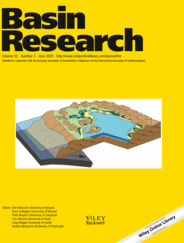
Full text loading...
 , Daniel F. Stockli1, Margaret L. Odlum1, Pauline Tolentino1, Cai Puigdefàbregas2, Julian Clark3, Andrea Fildani3
, Daniel F. Stockli1, Margaret L. Odlum1, Pauline Tolentino1, Cai Puigdefàbregas2, Julian Clark3, Andrea Fildani3
A provenance shift occurred during the Early Eocene in the Ager Basin. A sediment source region in the southern foreland dominated by Variscan granitic basement of the Ebro Massif is interpreted for the Cretaceous ‐ Paleocene strata. This changes to a source region in the northern fold‐and‐thrust belt for Early Eocene strata, eroding recycled Mesozoic strata with plutonic and metamorphic Paleozoic basement exhumed during the early stages of Pyrenean shortening.
This study constrains the sediment provenance for the Late Cretaceous–Eocene strata of the Ager Basin, Spain, and reconstructs the interplay between foreland basin subsidence and sediment routing within the south‐central Pyrenean foreland basin during the early phases of crustal shortening using detrital zircon (DZ) U‐Pb‐He double dating. Here we present and interpret 837 new DZ U‐Pb ages, 113 of which are new DZ (U‐Th)/He double‐dated zircons. U‐Pb‐He double dating results allow for a clear differentiation between different foreland and hinterland sources of Variscan zircons (280–350 Ma) by leveraging the contrasting thermal histories of the Ebro Massif and Pyrenean orogen, recorded by the zircon (U‐Th)/He (ZHe) ages, despite their indistinguishable U‐Pb age signatures. Cretaceous–Paleocene sedimentary rocks, dominated by Variscan DZ U‐Pb age components with Permian–Triassic (200–300 Ma) ZHe cooling ages, were sourced from the Ebro Massif south of the Ager Basin. A provenance shift occurred at the base of the Early Eocene Baronia Formation (ca. 53 Ma) to an eastern Pyrenean source (north‐east of the Ager Basin) as evidenced by an abrupt change in paleocurrents, a change in DZ U‐Pb signatures to age distributions dominated by Cambro‐Silurian (420–520 Ma), Cadomian (520–700 Ma), and Proterozoic–Archean (>700 Ma) age components, and the prominent emergence of Cretaceous–Paleogene (<90 Ma) ZHe cooling ages. The Eocene Corçà Formation (ca. 50 Ma), characterized by the arrival of fully reset ZHe ages with very short lag times, signals the accumulation of sediment derived from the rapidly exhuming Pyrenean thrust sheets. While ZHe ages from the Corçà Formation are fully reset, zircon fission track (ZFT) ages preserve older inherited cooling ages, bracketing the exhumation level within the thrust sheets to ca. 6–8 km in the Early Eocene. These DZ ZHe ages yield exhumation rate estimates of ca. 0.03 km/Myr during the Late Cretaceous–Paleocene for the Ebro Massif and ca. 0.2–0.4 km/Myr during the Eocene for the eastern Pyrenees.
]
Article metrics loading...

Full text loading...
References


Data & Media loading...

